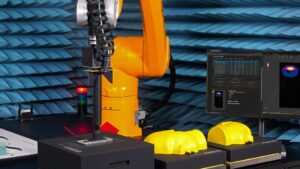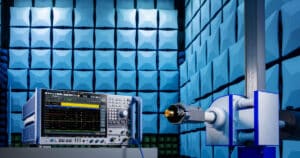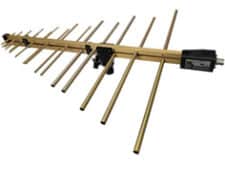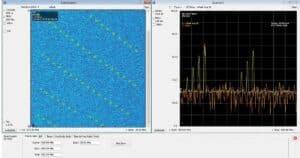SPEAG and Rohde & Schwarz expand their long-term collaboration with the combination of the CMX500 wideband radio communication tester with the DASY83D utilising the enhanced DASY8 Application Programming Interface. This combination allows manufacturers of wireless devices to perform Specific Absorption Rate tests of 5G FR1 devices using the future-proof CMX500 … [Read more...]
EMV 2025: Rohde & Schwarz Presents New Antenna for EMI Measurements in Frequency Range from 14.9 GHz to 44 GHz
At the EMV 2025 tradeshow in Stuttgart, Rohde & Schwarz displays for the first time its R&S HF1444G14 High-gain EMI microwave antenna with outstanding performance. The antenna covers a frequency range from 14.9 GHz to 44 GHz. It meets the requirements of the standards CISPR 16-1-4 and CISPR 16-2-3. Precise mechanical construction and optionally … [Read more...]
An Easy Way to Calculate a Microwave Wavelength in Inches
A colleague, Mike Stasiowski, and I came up with this quick GHz wavelength formula while designing quad ridge circular polarized jamming antennas for the military when working at Nurad. The textbook formula (wavelength = c/f) where: c = the speed of light 3.00×108 m/s, and f = frequency in Hz, was cumbersome at times to calculate, then convert, to inches for practical … [Read more...]
Antenna Factor Calculations and Deviations
Introduction In recent years, the use of a term call "Antenna Factor" in EMC and spectrum pollution work has become very important. There has been a great need for measuring field intensity and/or power density as accurately and conveniently as possible. Classically in RFI/EMI measurements, the use of antenna factors is very common. These antenna factors were, by … [Read more...]
Guide to Real-Time Spectrum Analyzers: Applications
This is Part 4 in a series of articles which review the basics of conventional swept versus real-time spectrum analyzers and highlight some of the recent advances and instrument form-factors. Read Part 1, Guide to Real-Time Spectrum Analyzers: Types, here. Read Part 2, Guide to Real-Time Spectrum Analyzers: Definitions, here. Read Part 3, Guide to Real-Time Spectrum … [Read more...]
Guide to Real-Time Spectrum Analyzers: Advantages of Swept Versus Real-Time Spectrum Analyzers
This is Part 3 in a series of articles which review the basics of conventional swept versus real-time spectrum analyzers and highlight some of the recent advances and instrument form-factors. Read Part 1, Guide to Real-Time Spectrum Analyzers: Types, here. Read Part 2, Guide to Real-Time Spectrum Analyzers: Definitions, here. Swept spectrum analyzers are simpler and … [Read more...]
Can 5G Sites Be Good Neighbors?
Baseball Hall of Famer Yogi Berra was notable for his skill on the field and was equally notable for many of his quotes. “Yogi-isms” were things he often said that were both amusing and insightful. Referring to a popular restaurant, he said, “Nobody goes there anymore; it’s too crowded.” Sounds like a contradiction, but it’s easy to follow his meaning. Customers chose not to … [Read more...]
Drag Races, a Cashless Society, and the Threat of EMP
About a month ago, my 12-year-old son and I made his first-ever trip to the NHRA Drag Races near our home. It’s something that I always did with my dad, and I have looked forward to taking him ever since he was born. It’s a typical father-and-son day, wrought with loud, fast cars, terrible food, and the occasional waft of nitromethane fuel in the air. The drive is about … [Read more...]
When Do You Need Low-Dk PCB Laminates?
Designers looking to build more advanced systems operating at higher data rates and bandwidths tend to rely on materials with low dielectric constant values, i.e., low-Dk materials. It has gotten to the point where every high-speed PCB design guide implies that high-speed and RF designs will not function without a low-Dk material like Rogers or Arlon. The reality is that … [Read more...]
Guide to Real-Time Spectrum Analyzers: Definitions
This is Part 2 in a series of articles which review the basics of conventional swept versus real-time spectrum analyzers and highlight some of the recent advances and instrument form-factors. Read Part 1, Guide to Real-Time Spectrum Analyzers: Types, here. Introduction There are several terms that are important when evaluating real-time spectrum analyzers. Some of these … [Read more...]
- 1
- 2
- 3
- …
- 89
- Next Page »














